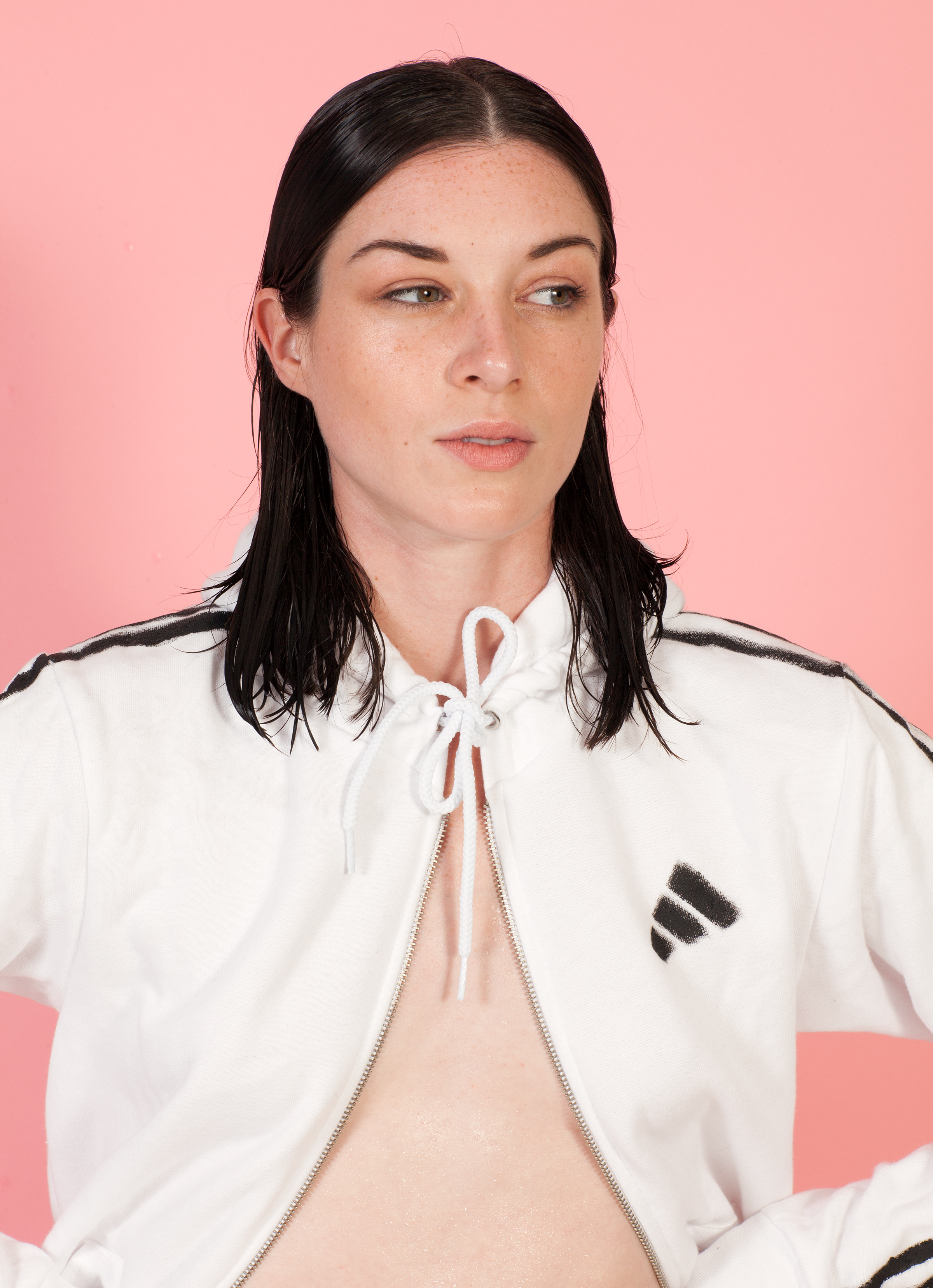Lafayette Anticipation associate curator Anna Colin talks to artist Tyler Coburn about Ergonomic Futures, a speculative project engaged with art, design, science, anthropology and writing. In this interview, Coburn discusses the research, production process and network of collaborators of a multilayered project ultimately concerned with the futures of humankind. Anna Colin: When one comes across your museum seats Ergonomic Futures (2016—) in contemporary art exhibitions—and soon in natural history, fine art, and anthropology museums—they look… [read more »]
Not Your Average It Girl: DISmiss presents Stoya

©Molly Matalon
Stoya is an adult film performer, feminist and writer. She has appeared in over 50 explicit films, writes a bi-monthly sex advice column for Refinery29 and is involved with the Adult Performer Advocacy Committee, which pushes for better education and working conditions for adult performers. 178k people eat up her sass on Twitter, and yes, she has Instagram: “It’s all pictures of cats,” she warns us on set.
With DISmiss, we celebrate the It Girl—the cool, the uncool, and everyone in between. In the first installment, Ada O’Higgins chats Stoya about directing her first porn film, being over acrylic nails and confronting the biases within the sex work industry.
Ada: The boundaries between porn and art have long been the subject of contention. How would you distinguish porn from art that uses pornographic elements?
Stoya: There’s a famous case about pornography where the Supreme Court Justice said he ‘knows it when he sees it.’ I think that’s one of the best—as loose and undefined as it is—definitions of pornography that I’ve heard. I kind of feel the same way about art: I don’t agree with the ‘well if it’s in a gallery it must be art’ attitude because there are some things that I see in galleries and it’s like man…this is a head game, there’s some artist somewhere laughing his butt off because some assholes put his piece on a wall and somebody else is going to pay money to stick it on their own wall.
You know pornography when you see it, and art is the same way for me. But the you that is seeing is inevitably subjective. Women often tell me they’d like to explore what’s sexually arousing to them but ‘don’t like mainstream porn’. And I’m like, ‘look around, there’s no accounting for taste and what people find sexually stimulating. You might be walking down the grocery store aisle and see a box of corn and be over the moon about it.’ I guess it would be a can, but the fact is that attraction is personal and subjective and strange.
Ada: Are there any porn films you would call art?
Stoya: Nowadays, the production and release schedule for films is so fast that there’s usually not much room to be creative. A porn film that definitely transcends the genre is Café Flesh, an incredible adult film from the ‘80s. The plot is basically a metaphor for porn, and the film is so centered around the theme of pornography; it folds onto itself and becomes art almost by accident.
Right now, there’s probably someone in Minnesota with a 5D or Super 8 camera making the most incredible stuff and hoarding it for himself on a private livejournal. I hope we can eventually see it.
Ada: Would you be interested in moving into other forms of pornography? What do you think about the relationship between the commercial porn you do with Digital Playground and more amateur forms of porn that are available online?
Stoya: The kind of porn that I worked on with Digital Playground is dead. The company was purchased two and a half years ago by basically the Walmart of porn, and there’s been this steady homogenization of all the brands they own. It became over-the-top and very uninspired; they squashed out all room for creativity. I gave them a chance, but hated everything about it. Then I made a movie for John Stagliano and his production company Evil Angel, and it was so much fun!
From there, I decided the move was to take my savings and make an explicit movie of my own—but not in the way everyone was telling me to do it (talk to a distributor, shoot a test scene and get a deal). I did it all my own way. For instance I wanted to make sure none of the performers had any acrylic nails, no nail-polish, please god no French manicures…At that moment I realized the project was a big giant reaction to what I’d spent my professional career doing with Digital. I said no plots—it’s a porno: people having sex in front of the camera and having fun.
In terms of distribution, I jokingly told my friend the other day I might have to ask someone to take me down to the parking lot of an adult convention and sell my movie from my car. But we’ll see what happens.
Ada: How do you manage confidence and vulnerability on screen?
Stoya: I have no idea. I have a really difficult time watching myself in anything; I even avoid reading interviews. Any sort of question like, ‘why do people connect with you’ or ‘why has your career been successful,’ I’m not sure how to answer. I’m uncomfortable looking at myself from the outside that way. Introspection is completely different. I have no problem with investigating parts of myself and thinking about them, and putting all sorts of information out on the internet. But when it comes to looking at the way someone else is perceiving me (like the general porn public), I can’t think about it.
Ada: So it’s instinctive, how you come across. You just go in and follow your instincts.
Stoya: Yes, I’m afraid that if I tried to calculate it, the whole thing would just fall apart.
Ada: The author Georges Bataille has written about the relationship between the erotic and death, arguing that the power of the erotic moment is similar to death in that it violently jerks us out of our obsession with the lastingness of our individual beings.
How have you experienced the link between erotica, violence and the death wish it is often associated with?
Stoya: Well, as far as the relationship between the erotic and violence, just look at the face of a person having an orgasm. If you were shown a close up of a person’s contorted face when they’re having an orgasm without any sort of context, they could be sobbing because they’re emotionally torn apart, they could be being tortured or in the throes of sexual pleasure, you can’t tell if you don’t have the context.
I ask people what they think about when they’re having an orgasm, and almost without fail they say, ‘well I’m looking into my partner’s eyes and having these feelings’ and I’m like no, not what gets you there, but the moment when you’re having an orgasm. I have yet to meet a single person who has a definitive answer about what they’re thinking about precisely when they’re having an orgasm. Your cognitive thought just pauses for a moment; what is going on is completely physical.
I do kind of wonder—I mean I’ve never died, so I can’t really compare—if it’s a similar sort of moment to death.
Ada: Don’t you think there’s a ritualistic aspect about the set, and the way plots seem to unravel in a certain sequence?
Stoya: When you look at the broad spectrum of porn films, the repetition is mostly formulaic laziness. They figured out what works and they kept doing it: there’s some pussy eating, some blow job, some penetrative sex, and then the guy is gonna ejaculate somewhere we can see it. That’s not the way all porn gets made, but it is one of the patterns. I don’t know if that comes from porn; there’s this deeply ingrained cultural idea that the end of sex is the male orgasm, and for women it’s like, ‘I didn’t get to come and my boyfriend did and now it’s over. How do I get him to take care of me after we’re done?’ Why is semen the end of the sentence? This notion goes back way before modern pornographic video. I think the ritualism related to pornography probably happens more so on the consumer’s end.
Ada: Could the private moment of pornography viewing and masturbation be seen as a replacement for the religious rituals that have lost importance in much of North America and Western Europe?
Stoya: I don’t think people put that much thought or effort or savoring of the moment into their consumption of pornography. But as I started to say that, I realized that I don’t know how much thought or consideration people put into religion, how many people go to church and listen to a sermon for an hour and then leave and mull it over until the next one?
One of the things that makes it hard to think critically about porn is that most of the time when it’s discussed, and I do this too, people who make and consume porn are treated as monoliths. It’s like asking, ‘what do people like about strawberries?’ Some people like the taste, others the texture, and some have no idea what they think.
Ada: You’ve talked about some of the biases people outside of the sex work industry tend to have. What sort of biases have you encountered within the sex work industry?
Stoya: Within the sex industry, a lot of the biases emerge between sub-groups. A single worker will have multiple jobs in the sex industry: a film performer will also dance at strip clubs and do webcam shows. Those are all very different professions.
When you put together sex workers who do different kinds of sex work, there will often be internal biases about the different kinds of sex work. Thanks to the internet and people needingto diversify their careers to make ends meet, there’s less porn being shot and more performers sitting around not working due to free internet porn dissemination. I feel like there’s more understanding among sex workers now. There was a moment when girls who did nude photos would say, ‘I don’t do porn’ and I would think, ‘what do you think they pay $15.95 a month for?’ There was a moment when a lot of holier-than-thou attitudes were going around, but that’s changing now.

“There was a moment when a lot of holier-than-thou attitudes were going around [with sex workers], but that’s changing now.”
Stoya: I had an Op-Ed in the Sunday issue of the New York Times and after that I think a lack of productivity is justified. People will be like, ‘what are you up to?’ and I’ll say, ‘well three months ago I had an Op-Ed in the New York Times, what did you do? Oh, not that? OK here’s a tissue for your tears of inadequacy.’ God I can be such a bitch! [laughs]
Ada: You’re making me feel inadequate.
Stoya: Sorry. But yeah I’ve been freelancing and figuring out what kind of writing suits me best. The thing about the writing industry, like the entertainment industry, is shit can fall through at any moment. So I try not to talk about any forthcoming projects until they’re public.
Photography: Molly Matalon
Photo assistant: Caroline Tompkins
Styling: Anna Soldner
All clothes DISown
DISmiss is an ongoing column celebrating our version of the It Girl—the cool, the uncool and everyone in between. Know someone who’s got the IT factor? Send suggestions to [email protected].












































































